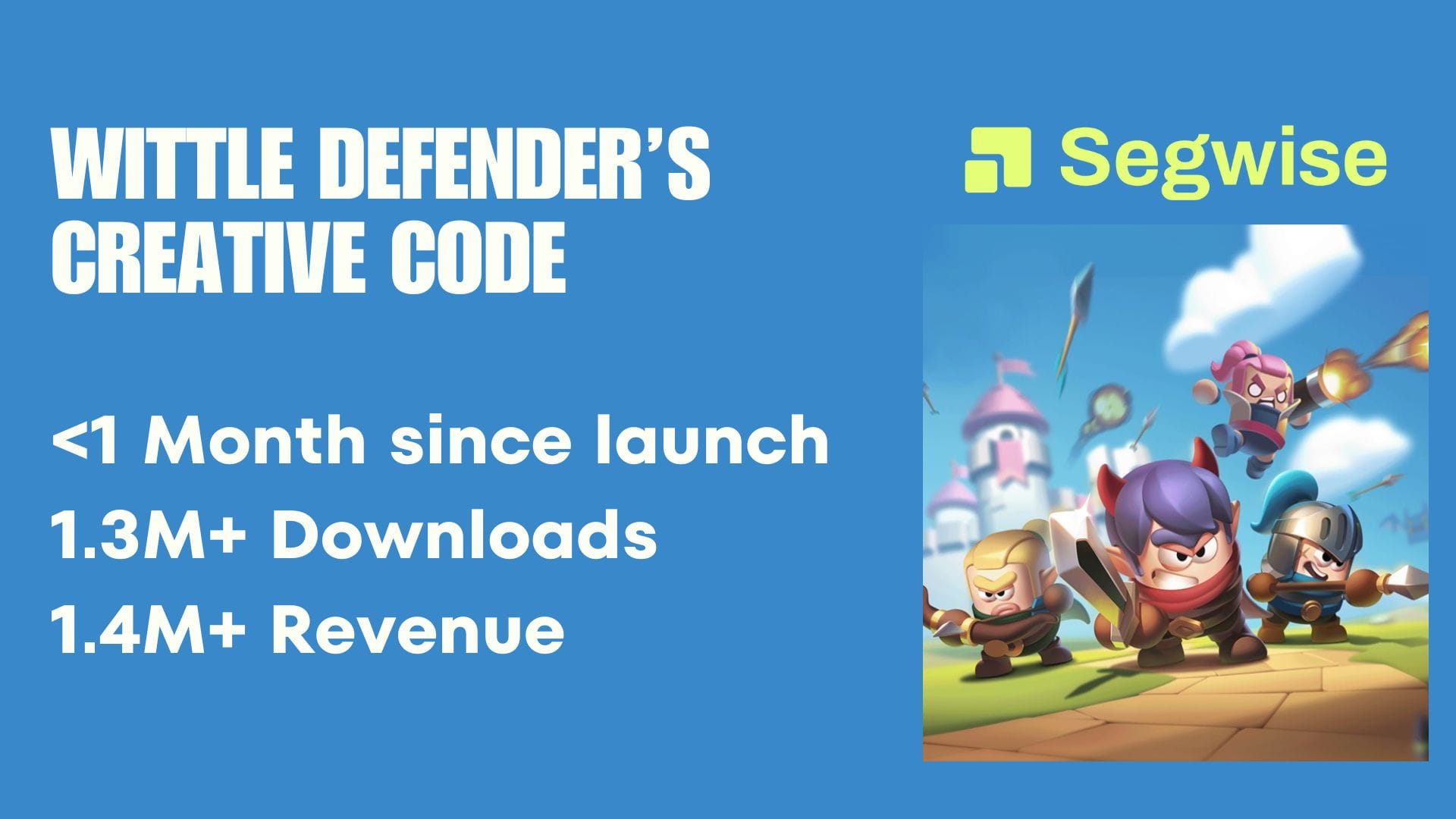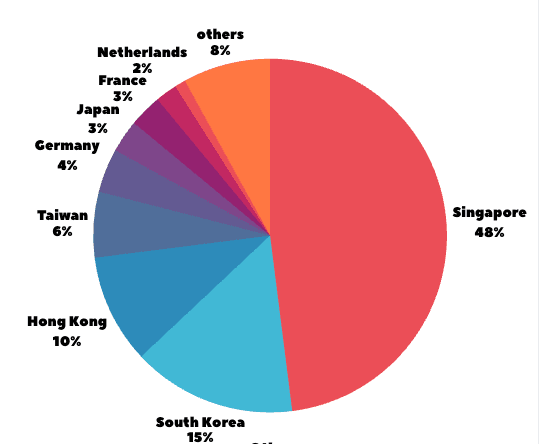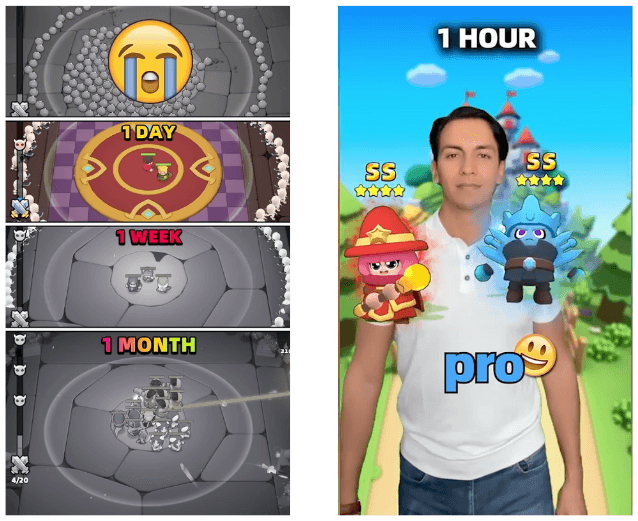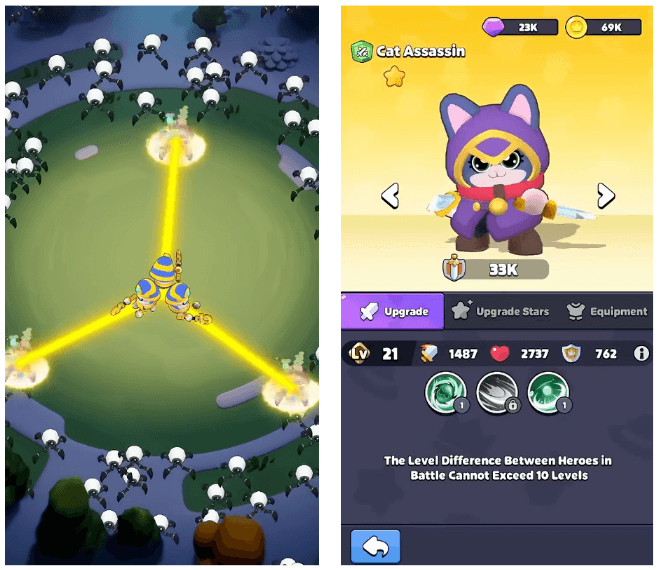How Habby’s Latest Hit Wittle Defender Generated $1.4M in <30 Days
A deep-dive analysis of the creative strategies powering one of 2025's fastest-growing mobile games
TL;DR: What You'll Learn
In under a month since launch, Habby's Wittle Defender has captured 1.3M+ downloads and generated $1.4M+ in IAP revenue. Through comprehensive creative analysis using creative tagging, we've decoded the creative patterns driving this explosive growth. You'll discover the three core creative strategies that account for 81.8% of their top-performing ads, why their "East-first" targeting approach is crushing traditional global rollouts, and specific experiments you can implement immediately to replicate their success.
Also read How Dunk City Dynasty Cracked the Creative Code: 3M+ Installs in <30-Days

The Mobile Gaming Gold Rush: Why Creative Intelligence Matters More Than Ever
Picture this: You're sitting in your Monday morning UA review, staring at declining ROAS numbers across all your campaigns. Your creative team is burning through concepts faster than you can test them, and that "winning" ad from last quarter is now bleeding money. Sound familiar?
This scenario plays out in mobile gaming studios worldwide every single day. The creative landscape shifts so rapidly that what worked yesterday becomes tomorrow's budget drain. Yet some studios consistently crack the code, launching hit after hit with surgical precision.
Habby is one of those studios. With previous successes like Archero 1 and 2, and Capybara Go!, they've developed a creative methodology that's both systematic and scalable. Their latest title, Wittle Defender, provides a masterclass in how data-driven creative strategy translates into explosive growth.
Deconstructing a Hit: What Makes Wittle Defender Special
Wittle Defender isn't just another tower defense game, it's a carefully crafted hybrid that blends tower defense mechanics with roguelike progression and card strategy elements. This genre fusion creates multiple creative angles to explore, but also presents unique marketing challenges.
The Market Reality Check
Before diving into creative strategies, let's understand the competitive landscape. Tower defense games face a saturation problem: the market is flooded with similar-looking titles making nearly identical promises. Standing out requires more than good gameplay - it demands creative strategies that communicate unique value propositions instantly.
Habby's solution? Target Eastern markets first, then expand West. This "East-first" approach allows them to validate creative concepts in markets where they have proven success patterns, then adapt winning formulas for Western audiences.
Geographic Targeting Breakdown:

- Singapore: 48% (Primary testing ground)
- South Korea: 15% (High-value market validation)
- Hong Kong: 10% (Cultural bridge testing)
- Taiwan: 6% (Secondary validation)
- Western markets: 21% (Scaled expansion)
This distribution reflects a sophisticated understanding of market dynamics and creative resonance patterns across different cultural contexts.
The Creative DNA: Three Pillars of Success
Through systematic analysis of their top-performing creatives, three dominant patterns emerge that account for the majority of Wittle Defender's success:
Pillar 1: Progression Showcase Mastery (36% of Top Ads)
The "Just Started" phenomenon represents Habby's most refined creative strategy. These ads follow a consistent progression narrative:
Hook: "Just Started" Evolution: 1 hour → 1 week → 1 month
Payoff: Dramatic character/capability transformation
Why this works: Mobile gamers are progression-driven. These creatives solve the fundamental question every potential player asks: "What will I have to show for my time investment?" By compressing weeks of gameplay into 25-30 seconds, they create an irresistible advancement fantasy.
Technical Implementation:
- Use split-screen or stacked screen formats
- Show actual gameplay progression, not conceptual graphics
- Include numerical progression indicators (levels, stats, unlocks)
- End with aspirational endgame content

Pillar 2: Battle Intensity (27.3% of Top Ads)
Habby has mastered what we call "controlled chaos" in their battle sequences. These aren't just action montages, they're carefully orchestrated psychological triggers.
The Formula:
- Overwhelming odds: Characters face impossible enemy waves
- Psychedelic intensity: Visual effects build to near-uncomfortable levels
- Strategic cliffhanger: Cut at peak tension without resolution
The psychology: This approach exploits the same mental triggers that make Dark Souls addictive. Players don't want to see easy victories, they want to prove they can overcome impossible challenges.
Critical insight: 27.3% of successful ads end without resolution, creating curiosity gaps that drive installs.
Pillar 3: Collection Psychology and Character Diversity (81.8% Feature Multiple Characters)
Character variety isn't just about gameplay depth, it's about player identity alignment. Wittle Defender's creative strategy showcases diverse character archetypes to maximize player opportunities.
Featured Archetypes:
- Mage: Appeals to strategy enthusiasts
- Lion Swordmaster: Attracts action-oriented players
- Cat Assassin: Draws in fantasy/anime demographics
- Crossbowman: Appeals to tactical shooter fans

Strategic application: Rather than focusing on a single protagonist, successful ads demonstrate the breadth of collection possibilities, triggering the need for a "gotta catch 'em all" psychology while allowing different player types to see themselves in the game.
Platform and Network Intelligence: Where the Magic Happens
Ad Network Distribution Strategy
YouTube dominance (50% of spend) reflects Habby's understanding of creative format requirements. YouTube Shorts short-form video capabilities align perfectly with their progression showcase strategy, allowing full narrative development in the videos.
Network breakdown:
- YouTube: 50% (Long-form progression narratives)
- AppLovin: 17% (Programmatic scale and optimization)
- Facebook: 14% (Detailed targeting capabilities)
- TikTok: 10% (Viral potential and younger demographics)
The Creative Format Revolution
72.7% of successful ads use gameplay footage rather than animated or conceptual content. This isn't coincidental, it reflects a fundamental shift in mobile gaming advertising toward authenticity and transparency.
Why gameplay dominates:
- Trust factor: Players have been burned by misleading ads
- Immediate comprehension: Actual gameplay communicates mechanics instantly
- Social proof: Real gameplay suggests confidence in the product
- Creative efficiency: Actual gameplay is faster and cheaper to produce than custom animation
Advanced Creative Techniques: The Details That Matter
Duration Optimization: The 25+ Second Sweet Spot
63.6% of successful ads are just above the 25 seconds mark, which keep the ads short and provides Wittle Defender's creative strategy sufficient time to communicate progression and value propositions.
Audio Strategy: The Underrated Creative Element
72.7% of ads use music-only audio tracks without voiceover or dialogue. This choice reflects several strategic considerations:
- Localization efficiency: Music translates across cultural boundaries
- Platform optimization: Many users watch without sound
- Production scalability: Music tracks are easier to test and iterate
- Emotional manipulation: Music can create specific emotional states without language barriers
Visual Storytelling Dominance
Only 36.4% of ads include hook text, indicating heavy reliance on visual narrative techniques. This approach requires sophisticated visual design but creates more immersive experiences and broader appeal across language barriers.
Replicating Success: Actionable Implementation Framework
1. Progression Showcase Testing
Implementation steps:
- Identify your game's most dramatic progression elements
- Character visual evolution
- Capability/power increases
- Environmental/content unlocks
- Social status indicators
- Create timeline benchmarks
- Day 1 baseline (tutorial completion)
- Week 1 milestone (first major unlock)
- Month 1 aspiration (endgame preview)
- Test progression narrative formats
- Split-screen comparisons
- Time-lapse transformations
- Before/after reveals
2. Controlled Chaos Battle Sequences
Implementation steps:
- Identify your game's peak intensity moments
- Boss battles with overwhelming odds
- Survival scenarios with escalating difficulty
- PvP moments showcasing skill gaps
- Engineer psychological escalation
- Start with manageable challenge
- Gradually increase visual/audio intensity
- Peak at moment of maximum tension
- Cut before resolution (25% of the time)
- Test tension variation
- Complete victory sequences
- Cliffhanger endings
- Failure-to-success narratives
3. Character Collection Showcases
Implementation steps:
- Audit your character/unit diversity
- Visual variety across character designs
- Gameplay role differentiation
- Thematic/aesthetic appeal ranges
- Create identification opportunities
- Show characters in action, not just portraits
- Demonstrate unique abilities and roles
- Include personality/emotional elements
- Test collection presentation formats
- Character parade/montage formats
- Team composition demonstrations
- Unlock sequence reveals
The Broader Strategic Context: Why This Matters Beyond Wittle Defender
Creative Pattern Recognition as Competitive Advantage
The ability to systematically analyze and replicate successful creative patterns represents a fundamental competitive advantage in mobile gaming. Studios that develop these capabilities can:
- Reduce creative development time by focusing on proven patterns
- Improve testing efficiency by understanding success indicators
- Scale creative production through systematic approaches
- Adapt competitor insights for their own apps/products
The Evolution of Mobile Game Marketing
Wittle Defender's success represents broader trends reshaping mobile game marketing:
From intuition to intelligence: Creative decisions increasingly rely on data analysis rather than creative instinct alone.
From universal to cultural: Successful campaigns adapt creative strategies for specific cultural contexts rather than assuming universal appeal.
From features to feelings: The most effective creatives focus on emotional experiences rather than feature lists or mechanical explanations.
Conclusion: From Analysis to Action
Wittle Defender's $1.4M revenue achievement in less than 30 days from launch isn't the result of creative genius or lucky timing, it's the product of systematic creative strategy development and execution. The three core patterns we've identified (progression showcases, controlled chaos, and character collection psychology) provide a replicable framework for creative success.
The key insight: Successful mobile game creatives aren't about individual brilliant ideas—they're about systematic understanding of player psychology and technical execution of proven patterns.
The mobile gaming landscape will continue evolving rapidly, but the studios that develop systematic creative intelligence capabilities will consistently outperform those relying on intuition alone. Segwise allows you to do exactly that and scale your creative ROAS with it's AI Creative Agent. The agent automatically tags and analyzes all your creative elements across your ad networks and highlights winning data patterns for you.
What creative patterns are you seeing in your own campaigns?
This analysis was conducted using Segwise's creative tagging and analysis agent.

Comments
Your comment has been submitted successfully!